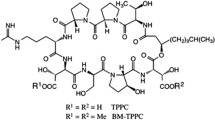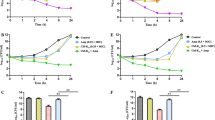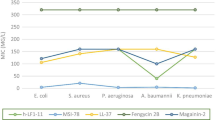Abstract
In this study, the antimicrobial activities based on the synergistic effects of traditional antibiotics (imipenem, cefepime, levofloxacin hydrochloride and vancomycin) and antimicrobial peptides (AMPs; PL-5, PL-31, PL-32, PL-18, PL-29 and PL-26), alone or in combination, against three Gram-positive bacteria (Staphylococcus aureus, Streptococcus pneumoniae and Staphylococcus epidermidis) and three Gram-negative bacteria (Pseudomonas aeruginosa, Escherichia coli and Klebsiella pneumoniae) were investigated. In addition, the antimicrobial activity that was based on the synergistic effects of levofloxacin hydrochloride and PL-5 against Staphylococcus aureus in vivo was explored in a mouse infection model. Traditional antibiotics and AMPs showed significant synergistic effects on the antibacterial activities against the different Gram-positive and Gram-negative bacteria in vitro. A strong synergistic effect in the PL-5 and levofloxacin hydrochloride combination against Staphylococcus aureus was observed in the mouse infection model in vivo. The mechanism of synergistic action was due to the different targets of AMPs and traditional antibiotics. The combination of AMPs and traditional antibiotics can dramatically enhance antimicrobial activity and may help prevent or delay the emergence of antibiotic resistance. Thus, this combination therapy could be a promising approach to treat bacterial infections, particularly mixed infections and multi-antibiotic-resistant infections, in the clinics.

Similar content being viewed by others
References
Troillet N, Samore MH, Carmeli Y (1997) Imipenem-resistant Pseudomonas aeruginosa: risk factors and antibiotic susceptibility patterns. Clin Infect Dis 25:1094–1098
Hardin TC, Jennings TS (1994) Cefepime. Pharmacotherapy 14:657–668
Davis R, Bryson HM (1994) Levofloxacin. A review of its antibacterial activity, pharmacokinetics and therapeutic efficacy. Drugs 47:677–700
Ge M, Chen Z, Onishi HR, Kohler J, Silver LL, Kerns R, Fukuzawa S, Thompson C, Kahne D (1999) Vancomycin derivatives that inhibit peptidoglycan biosynthesis without binding D-Ala-D-Ala. Science 284:507–511
Fernandes P (2006) Antibacterial discovery and development—the failure of success? Nat Biotechnol 24:1497–1503
Safdar N, Handelsman J, Maki DG (2004) Does combination antimicrobial therapy reduce mortality in Gram-negative bacteraemia? A meta-analysis. Lancet Infect Dis 4:519–527
Spiegel CA (1988) Laboratory detection of high-level aminoglycoside-aminocyclitol resistance in Enterococcus spp. J Clin Microbiol 26:2270–2274
Bliziotis IA, Samonis G, Vardakas KZ, Chrysanthopoulou S, Falagas ME (2005) Effect of aminoglycoside and beta-lactam combination therapy versus beta-lactam monotherapy on the emergence of antimicrobial resistance: a meta-analysis of randomized, controlled trials. Clin Infect Dis 41:149–158
Hirano L, Bayer AS (1991) Beta-Lactam-beta-lactamase-inhibitor combinations are active in experimental endocarditis caused by beta-lactamase-producing oxacillin-resistant staphylococci. Antimicrob Agents Chemother 35:685–690
Grindey GB, Nichol CA (1972) Interaction of drugs inhibiting different steps in the synthesis of DNA. Cancer Res 32:527–531
Cirioni O, Ghiselli R, Orlando F, Silvestri C, Mocchegiani F, Rocchi M, Chiodi L, Abbruzzetti A, Saba V, Scalise G, Giacometti A (2007) Efficacy of colistin/rifampin combination in experimental rat models of sepsis due to a multiresistant Pseudomonas aeruginosa strain. Crit Care Med 35:1717–1723
De Clercq E (2004) Antiviral drugs in current clinical use. J Clin Virol 30:115–133
Cirioni O, Giacometti A, Ghiselli R, Kamysz W, Orlando F, Mocchegiani F, Silvestri C, Licci A, Chiodi L, Lukasiak J, Saba V, Scalise G (2006) Citropin 1.1-treated central venous catheters improve the efficacy of hydrophobic antibiotics in the treatment of experimental staphylococcal catheter-related infection. Peptides 27:1210–1216
Hancock RE, Chapple DS (1999) Peptide antibiotics. Antimicrob Agents Chemother 43:1317–1323
Zasloff M (2002) Antimicrobial peptides of multicellular organisms. Nature 415:389–395
Chen Y, Guarnieri MT, Vasil AI, Vasil ML, Mant CT, Hodges RS (2007) Role of peptide hydrophobicity in the mechanism of action of alpha-helical antimicrobial peptides. Antimicrob Agents Chemother 51:1398–1406
Hancock RE (1998) The therapeutic potential of cationic peptides. Expert Opin Investig Drugs 7:167–174
Marr AK, Gooderham WJ, Hancock RE (2006) Antibacterial peptides for therapeutic use: obstacles and realistic outlook. Curr Opin Pharmacol 6:468–472
Chen Y, Mant CT, Farmer SW, Hancock RE, Vasil ML, Hodges RS (2005) Rational design of alpha-helical antimicrobial peptides with enhanced activities and specificity/therapeutic index. J Biol Chem 280:12316–12329
Pillai SK, Moellering R, Eliopoulos GM (2005) Antimicrobial combinations. Antibiot Lab Med 5:365–440
Petersen PJ, Labthavikul P, Jones CH, Bradford PA (2006) In vitro antibacterial activities of tigecycline in combination with other antimicrobial agents determined by chequerboard and time–kill kinetic analysis. J Antimicrob Chemother 57:573–576
Wiegand I, Hilpert K, Hancock RE (2008) Agar and broth dilution methods to determine the minimal inhibitory concentration (MIC) of antimicrobial substances. Nat Protoc 3:163–175
Zhu L-W, Shi L-M, Jiang J-X, Yang Z-K, Chen P (2008) Studies on Antibacterial Properties of the Natural Bamboo Fabric Based on FZ/T 73023—2006 [J]. J Donghua Univ (Nat Sci) 4:005
Zhang L, Benz R, Hancock RE (1999) Influence of proline residues on the antibacterial and synergistic activities of alpha-helical peptides. Biochemistry 38:8102–8111
Zhang L, Falla T, Wu M, Fidai S, Burian J, Kay W, Hancock RE (1998) Determinants of recombinant production of antimicrobial cationic peptides and creation of peptide variants in bacteria. Biochem Biophys Res Commun 247:674–680
Zhao LJ, Huang YB, Gao S, Cui Y, He D, Wang L, Chen YX (2013) Comparison on effect of hydrophobicity on the antibacterial and antifungal activities of α-helical antimicrobial peptides. Science China (Chemistry) 56:1307–1314
Hong SY, Oh JE, Lee KH (1999) Effect of D-amino acid substitution on the stability, the secondary structure, and the activity of membrane-active peptide. Biochem Pharmacol 58:1775–1780
Nichols RL, Graham DR, Barriere SL, Rodgers A, Wilson SE, Zervos M, Dunn DL, Kreter B (1999) Treatment of hospitalized patients with complicated gram-positive skin and skin structure infections: two randomized, multicentre studies of quinupristin/dalfopristin versus cefazolin, oxacillin or vancomycin. Synercid Skin and Skin Structure Infection Group. J Antimicrob Chemother 44:263–273
Ehrenstein G, Lecar H (1977) Electrically gated ionic channels in lipid bilayers. Q Rev Biophys 10:1–34
Andersson DI (2003) Persistence of antibiotic resistant bacteria. Curr Opin Microbiol 6:452–456
Davies J (1994) Inactivation of antibiotics and the dissemination of resistance genes. Science 264:375–382
Livermore DM (2003) Bacterial resistance: origins, epidemiology, and impact. Clin Infect Dis 36:S11–S23
Mataraci E, Dosler S (2012) In vitro activities of antibiotics and antimicrobial cationic peptides alone and in combination against methicillin-resistant Staphylococcus aureus biofilms. Antimicrob Agents Chemother 56:6366–6371
Jenssen H, Hamill P, Hancock RE (2006) Peptide antimicrobial agents. Clin Microbiol Rev 19:491–511
Shai Y (1999) Mechanism of the binding, insertion and destabilization of phospholipid bilayer membranes by alpha-helical antimicrobial and cell non-selective membrane-lytic peptides. Biochim Biophys Acta 1462:55–70
Chen Y, Vasil AI, Rehaume L, Mant CT, Burns JL, Vasil ML, Hancock RE, Hodges RS (2006) Comparison of biophysical and biologic properties of alpha-helical enantiomeric antimicrobial peptides. Chem Biol Drug Des 67:162–173
Acknowledgements
This work was supported by the National Natural Science Foundation of China (no. 81373445, Y. X. C.), the Innovative Team of Peptide Drugs of Jilin Province (no. 20121807, Y. X. C.), the Natural Science Foundation of Jilin Province (no. 20140101042JC, Y. B. H.) and a Basic Scientific Research Grant from Jilin University (Y. X. C. and Y. B. H.).
Conflict of interest
The authors declare that they have no conflict of interest.
Author information
Authors and Affiliations
Corresponding author
Electronic supplementary material
Below are the links to the electronic supplementary material.
Figure S1
Analytical RP-HPLC chromatograms of purified peptides. Column: reversed-phase Zorbax SB-300-C8 (150-mm × 4.6-mm inner diameter); experiments were carried out with a linear AB gradient (1 % B/min) at a flow rate of 1 ml/min. Eluent A was 0.1 % aqueous trifluoroacetic acid (TFA) and eluent B was 0.1 % TFA in acetonitrile. The sequences of the peptides are shown in Table 1. (GIF 38 kb)
Figure S2
Mass spectra of peptides. Mass spectrometry analyses were conducted using an AB SCIEX MALDI TOF/TOF 5800 Analyzer (AB SCIEX, USA). Mass spectra were acquired in the reflector mode in the m/z 1,000–4,000 mass range. The sequences of the peptides are shown in Table 1. (GIF 42 kb)
Table S1
(DOC 58 kb)
Rights and permissions
About this article
Cite this article
Feng, Q., Huang, Y., Chen, M. et al. Functional synergy of α-helical antimicrobial peptides and traditional antibiotics against Gram-negative and Gram-positive bacteria in vitro and in vivo. Eur J Clin Microbiol Infect Dis 34, 197–204 (2015). https://doi.org/10.1007/s10096-014-2219-3
Received:
Accepted:
Published:
Issue Date:
DOI: https://doi.org/10.1007/s10096-014-2219-3




